Microfilaments vs Microtubules: What is the difference between microfilaments and microtubules?
Microfilaments and microtubules are both important elements of the cytoskeleton, maintaining the structure and integrity of the cell, but there are several differences between microfilaments and microtubules. In this article, we share this information on microfilaments versus microtubules.
Microfilament and Microtubulues are made from different individual subunits. Microfilaments are made from ACTIN, while microtubules are made from TUBULIN.

Microfilaments = Actin
Microtubules = Tubulin
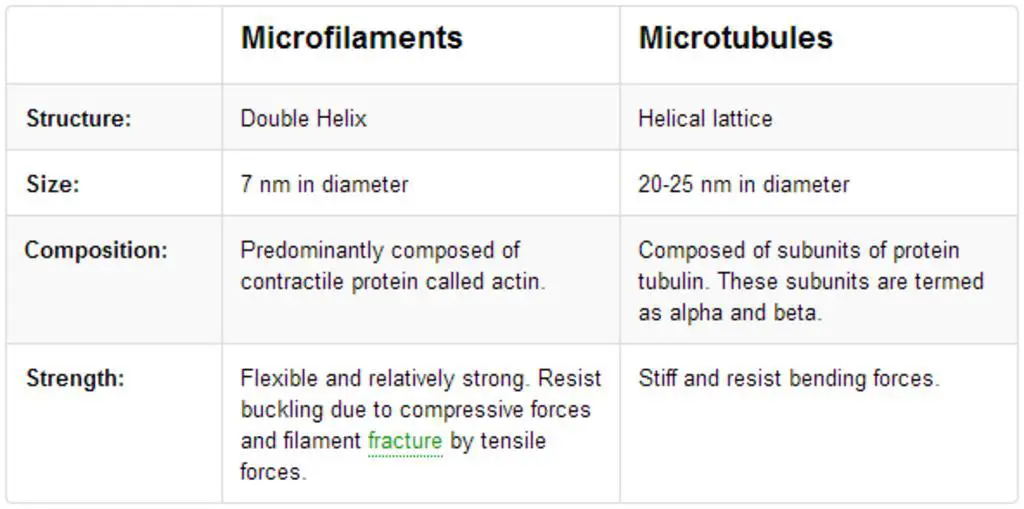
Difference in Microtubule and Microfilament Reorgnization
The process of adding on or removing monomers from microfilaments and microtubules differs. For microfilaments, actin monomers can be added to either end of the filament, including the barbed end (positive end) and the pointed end (negative end). For microtubules, unlike microfilaments, tubulin monomers are only added and removed on the positive end. In microtubules, a tubulin heterodimer consisting of beta-tubulin and alpha-tubulin is added or removed each time. Microtubules have gamma-tubulin proteins at the minus ends of the complex that prevent removal or addition of tubulin on that minus end. In fact, during mitosis and meiosis, gamma tubulin complexes are loosely organized around centrioles.
Microfilaments: Added on either end (plus or minus)
Microtubules: Added only on the plus end
Microtubules: have gamma-tubulin proteins on the minus end, prevents addition or removal of tubulin
Mitosis requires 2 centrosomes whose spindles are made up of microtubules, not microfilaments. These microtubules in the spindles help position chromosomes in the middle of the cell during metaphase and pull them apart during anaphase.
Microtubules grow and shrink only on the plus end. When the plus end is capped with GTP bound tubulin, the microtubule is stable and no longer grows. When the plus end is capped with GDP bound tubulin at the end, microtubule is unstable and can shrink.
Another difference between microtubules and microfilaments is that for microfilaments, nucleating complexes are involved in initiating filament formation. There are 3 proteins involved in filament formation: actin, Arp2, and Arp3. They make a nucleating complex, bind to either minus or plus end on the microfilament.
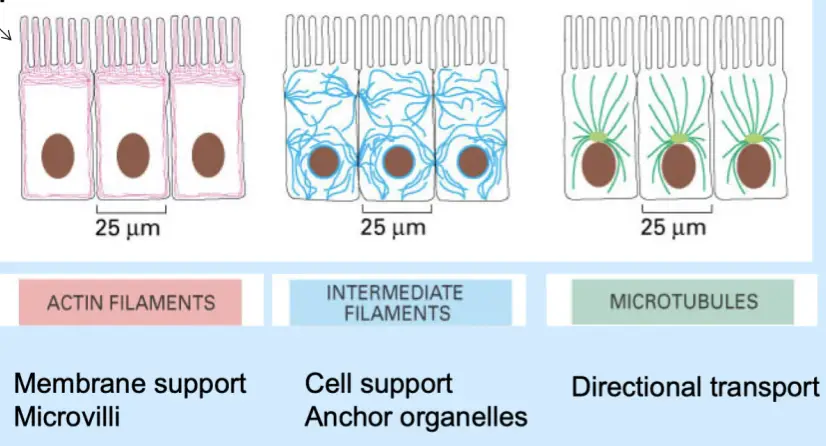
Microfilament Regulating Actin Assembly Rates
Actin-profilin complex causes rapid plus-end growth. Actin-thymosin complex inhibits binding and plus-end growth. Profilin and thymosin compete with each other for the binding of actin monomers and the promotion of microfilament assembly.
Microfilament: Arp2 + Arp3 + Actin = Nucleating complex to start formation
Microfilament: Actin-thymosin = Inhibit vs Actin-profilin = Proliferate/Grow
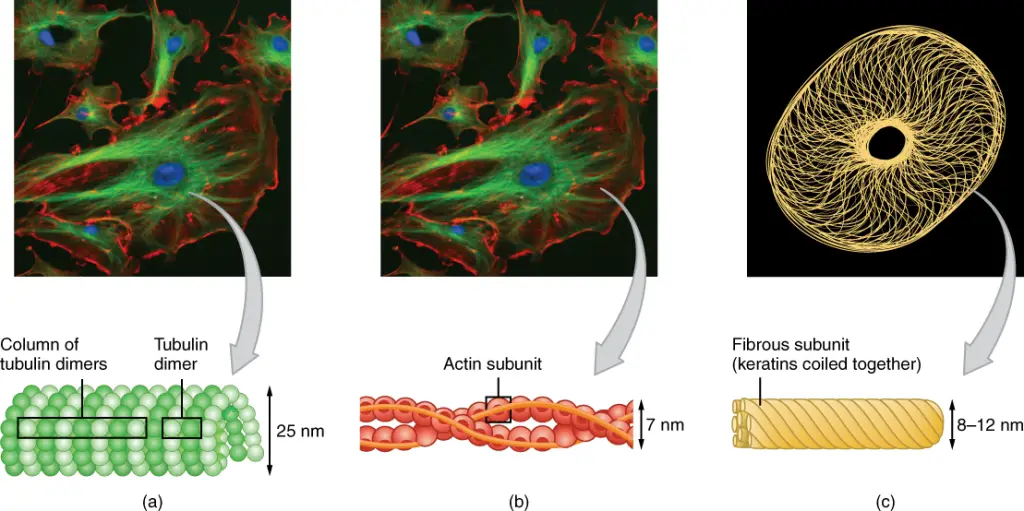
Difference in Examples: Microfilament vs Microtubule
Actin/microfilament in microvilli of small intestines
Platelet activation: actin filament plays a role here in change of cellular shape
Movement of neutrophils and lamellipodiums driven by actin polymerization
Example of Microtubules: sperm movement, mitosis and meiosis with spindles and centrosomes, cilia on trachea, modified cilia on rod cells in the eye

Difference in Diseases: Microfilament vs Microtubule
Disease of Microfilaments: mutation in cardiac myosin gene can cause atrial hypertrophy.
Disease of Microtubules: Kartagners Disease with mucus, respiratory problems because cilia not working, unique symptom is invertus of organs, heart on the right side, flipped organs
Difference in Motor Proteins between Microfilaments and Microtubules
Actin microfilaments: myosin is the main motor.
Microtubules: kinesins and dyneins are the main motor proteins. Kinesins deliver away from the center of the cell, to the outside. Dynein delivers and transports things back to the cell, towards the middle of the cell.
Dynein causes cilia to bend, creating motive force. In isolated doublet microtubules, dynein causes microtubules to slide across each other. Dynein can also cause microtubules to bend if there are linking proteins.
Microtubule: CILIA in trachea/lungs/eyes/kidney
Microfilament: MICROVILLI in small intestines
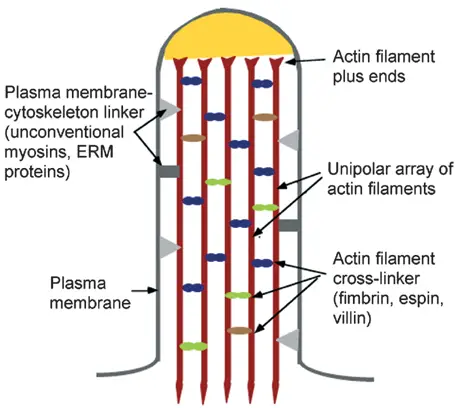
Similarity between Microfilament and Microtubules
Both help control cell shape and organization.
Both microtubules and microfilaments promote cellular movement.
Both microtubules and microfilaments serve as tracks for motor proteins.
Both have protein subunits that bind to nucleotides like ATP or GTP. True similarity! Remember earlier how we talked about microtubules with GTP caps and microfilaments with ATP with actin and myosin heads.
Last similarity of microtubules and microfilaments is that they are both part of the awesome cytoskeleton of our cells.
For more information, check out our articles below 😀
Immunology 101: Innate Immunity vs. Adaptive Immunity
Cell Membrane Dynamics: Flippase Vs Floppase Vs Scramblase
Cell Membrane: What types of molecules can pass through the cell plasma membrane?
Cell Membrane Fluidity: Factors That Influence and Increase the Cell Membrane Fluidity

Copyright © 2022 Moosmosis Organization: All Rights Reserved
All rights reserved. This essay first published on moosmosis.org or any portion thereof may not be reproduced or used in any manner whatsoever
without the express written permission of the publisher at moosmosis.org.

Please Like and Subscribe to our Email List at moosmosis.org, Facebook, Twitter, Youtube to support our open-access youth education initiatives! 🙂






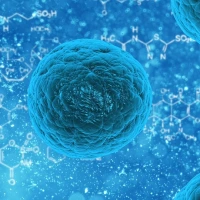

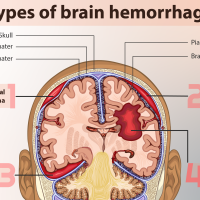




Excellent article on microfilaments versus microtubules! Made my cells smarter! 😀
LikeLiked by 1 person
Awesome essay on their similarities and differences!
LikeLiked by 1 person
Helpful!
LikeLiked by 1 person
I’m a cell biologist by training! I love this great info!
LikeLiked by 1 person
Brilliant and good to know. The microtubules and microfilaments have been running my cells.
LikeLiked by 1 person
Love this article on microtubules versus microfilaments!
LikeLiked by 1 person
Excellent points on the differences between microtubules and microfilaments!
LikeLiked by 2 people
Superb! When I took cell biology class, the microfilaments and microtubules were a challenge — great explanations!
LikeLiked by 1 person
Biology — a wonderful field. Microfilaments and microtubules abound. Keep the cells thriving. Excellent essay.
LikeLiked by 2 people
Fascinating! Who knew such cool structures exist in the human body. Great read!
LikeLiked by 2 people
Thank you!
LikeLiked by 1 person
Very well written and superb explanations on microfilaments vs microtubules!!
LikeLiked by 2 people